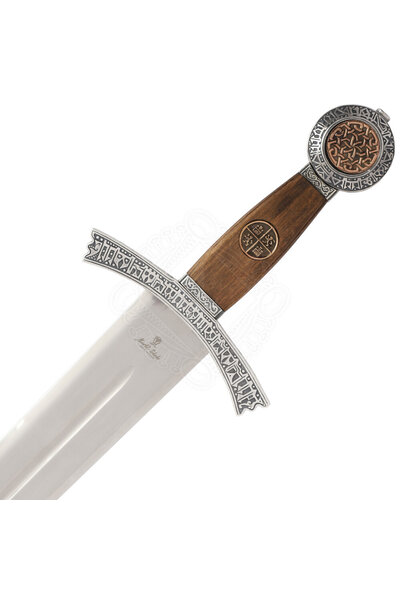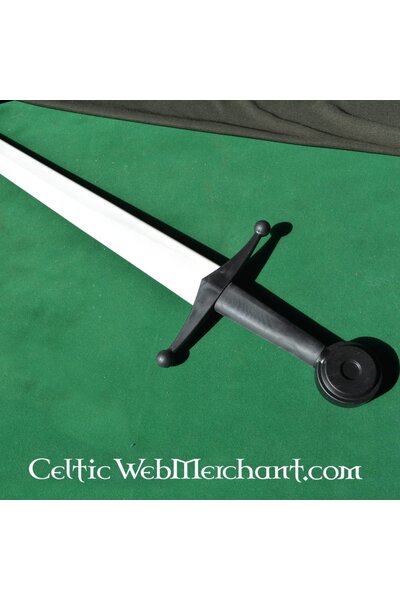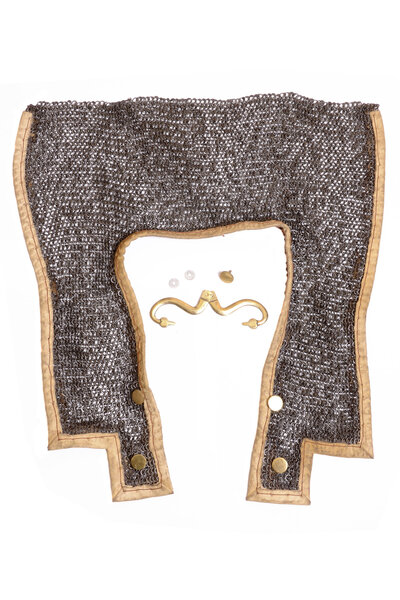Product description
Sancho IV of Castile, known as "el Bravo," ruled as the King of Castile, León, and Galicia from 1284 until his death in 1295. Upon the death of his father, Alfonso X, Sancho took control of the kingdom, despite his father's wishes. He was crowned in Toledo, where he ruled until his untimely death. Just before passing away, he appointed his wife, María de Molina, as regent for their young son, Ferdinand IV. Sancho died in 1295, and his body was buried in the Cathedral of Toledo, fulfilling his final wishes. In 1947, his remains were discovered in a well-preserved state, clothed in a Franciscan habit and adorned with a silver gilt crown decorated with Roman cameos and sapphires. A sword was found beside him, with an overgrown handle, and an inscription on its blade, though only fragments remain.
The sword, dating back to the 13th century, is an exceptional example of medieval weaponry. It was in excellent condition when found and reflects the status of a Castilian monarch. The blade is finely polished, showcasing the expertise of its craftsmanship. The cross-guard is a classic design with slightly curved arms and a lobed knob, featuring intricate ornamentation, including a possible Arabic inscription that repeats in a seemingly random pattern. The grip's decoration complements the rest of the sword and mirrors the symbols of the Kingdom of Castile and León, further emphasizing its royal heritage. Based on the size of the grip, it is believed that Sancho IV was a tall man, well over two meters in height, suggesting that the sword, like the crown, may have been inherited from his father, as was customary for royalty at the time.
The pommel of the sword is intricately chiseled, displaying beautiful Arabic designs on the two circular faces, while the lateral surfaces of the cones feature repeating motifs similar to those found on the cross. This stunning weapon, now on display at the Tapestry Museum of the Cathedral of Toledo, offers a glimpse into the lavish trousseau of Sancho IV, alongside his crown and pillow, preserving the legacy of a remarkable monarch.
Details:
Overall length 101.5cm
Blade length 83cm
Handle length 11cm
Length of crossguard 16.2cm
Length of the fuller 29.5cm
Blade width at the guard approx. 57mm
Blade width 10cm off the blade point 33mm
Thickness of the striking edge 1mm
The point of balance is about 20.5cm off the guard
Weight approx. 1808 g
Based on a historical original
Shipment weight (g): 2000 *
We do not sell this product to customers under the age of 18. Click here for more information on the European arms acts.
This item is produced in limited quantities only. This means that every piece is unique. Sizes & finish may vary lightly from piece to piece.
Prevent rust and corrosion by oiling your weapons regularly. Remove rust easily with black sandpaper. Remove burrs with a whetstone. Make sure you have removed all burrs before using a battle-ready weapon, as they can cause wounds.
Tip: How to adjust the finish of your armour and weaponry
Luxurious (polished)- polish the steel with metal polish or toothpaste. You can even give the item a mirror-like polish. Test on a small surface first!
Handmade (matte)- soak the steel in cola for 40 minutes to 20 hours. Check regularly and treat with black sandpaper.
Antique (patinated) leave the steel to rust for some time in a damp environment, preferably outside. Remove the red layer of rust, to reveal the corroded top layer.
Please note. After finishing the product yourself, the warranty and return right expire. Celtic WebMerchant is not responsible for the obtained result."
When packaging this item, we exclusively use 100% recycled plastic and recycled paper/cardboard from FSC certified forests. We reuse a large part of the material directly without the intervention of a recycling process.
Recycle the material by separating your waste:
1. Cardboard: separate or reuse your paper.
2. Plastic cushions, clothing bags and plastic tape: separate or reuse your plastic. If possible, pierce the cushions with a volume reduction needle.
3. Paper packaging for jewelry and small items: these have a plastic inner layer. Remove these, then separate your paper and plastic.
Read here about how we are committed to sustainability.










